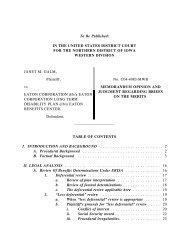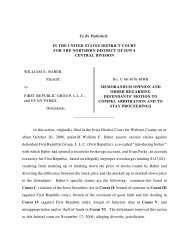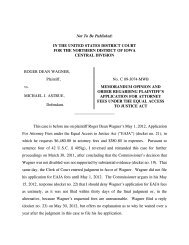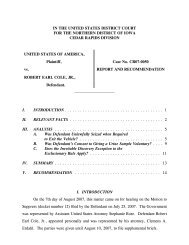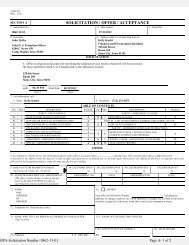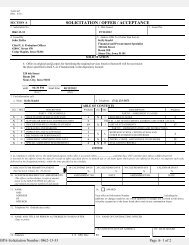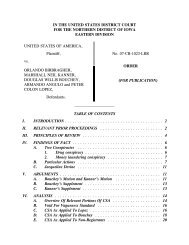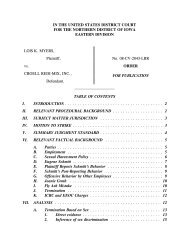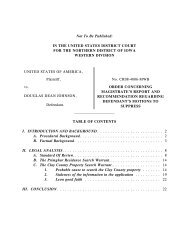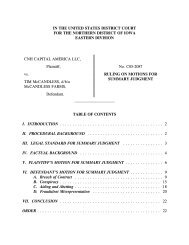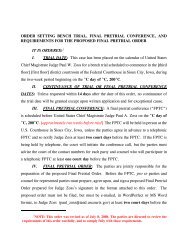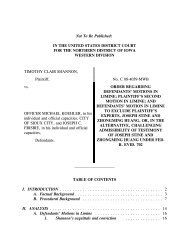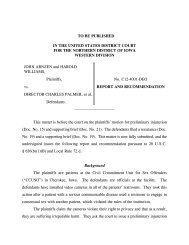G:\Jennifer80\PDFstaging\MWB,12-CR-4011, USA v. Dana Gleaves ...
G:\Jennifer80\PDFstaging\MWB,12-CR-4011, USA v. Dana Gleaves ...
G:\Jennifer80\PDFstaging\MWB,12-CR-4011, USA v. Dana Gleaves ...
You also want an ePaper? Increase the reach of your titles
YUMPU automatically turns print PDFs into web optimized ePapers that Google loves.
Not To Be Published:<br />
IN THE UNITED STATES DISTRICT COURT<br />
FOR THE NORTHERN DISTRICT OF IOWA<br />
WESTERN DIVISION<br />
UNITED STATES OF AMERICA,<br />
Plaintiff, No. <strong>CR</strong><strong>12</strong>-<strong>4011</strong>-MWB<br />
vs. ORDER REGARDING<br />
MAGISTRATE’S REPORT AND<br />
DANA GLEAVES,<br />
RECOMMENDATION<br />
CONCERNING DEFENDANT’S<br />
Defendant.<br />
MOTION TO SUPPRESS<br />
____________________<br />
TABLE OF CONTENTS<br />
I. INTRODUCTION AND BACKGROUND .......................... 2<br />
A. Procedural Background ................................ 2<br />
B. Factual Background ................................... 3<br />
II. LEGAL ANALYSIS ....................................... 8<br />
A. Standard Of Review ................................... 8<br />
B. Objections To Report and Recommendation .................. 13<br />
1. Probable Cause .............................. 13<br />
2. Leon good faith exception ........................ 20<br />
III. CONCLUSION ........................................ 26
I. INTRODUCTION AND BACKGROUND<br />
A. Procedural Background<br />
On February 23, 20<strong>12</strong>, an Indictment was returned against defendant <strong>Dana</strong> <strong>Gleaves</strong><br />
charging him with sexual exploitation of a child, in violation of 18 U.S.C. §§ 2251(a) and<br />
2251(e). On April 9, 20<strong>12</strong>, <strong>Gleaves</strong> filed a Motion to Suppress in which he seeks to<br />
suppress evidence seized during searches of his residence and business conducted pursuant<br />
to a search warrant. <strong>Gleaves</strong> argues that the search warrant application was not supported<br />
by probable cause. Specifically, he asserts that there was “insufficient evidence presented<br />
to the issuing state judge to establish the requisite nexus between Defendant’s residence<br />
and any crime involving child pornography.” Defendant’s Br. at 3. Thus, <strong>Gleaves</strong> argues<br />
the evidence was obtained in violation of the Fourth Amendment of the United States<br />
Constitution and must be suppressed. <strong>Gleaves</strong> also argues that suppression of the<br />
evidence is appropriate because the Leon good-faith exception is inapplicable. See United<br />
States v. Leon, 468 U.S. 897, 922-23 (1984). Specifically, he contends that the affidavit<br />
in support of the search warrant is so lacking in indicia of probable cause “as to render<br />
official belief in its existence entirely unreasonable.” Id. at 923.<br />
<strong>Gleaves</strong>’s Motion to Suppress was referred to United States Magistrate Judge Jon<br />
Stuart Scoles, pursuant to 28 U.S.C. § 636(b). On April 24, 20<strong>12</strong>, Judge Scoles<br />
conducted an evidentiary hearing at which the prosecution presented the testimony of Sioux<br />
City Police Officer Troy Hansen. On April 27, 20<strong>12</strong>, Judge Scoles filed a Report and<br />
Recommendation in which he recommends that <strong>Gleaves</strong>’s Motion to Suppress be denied.<br />
In his Report and Recommendation, Judge Scoles found that <strong>Gleaves</strong>’s Motion to<br />
Suppress was not timely filed. Judge Scoles does not recommend denying the motion on<br />
that ground because to do so could invite a later claim for ineffective assistance of counsel.<br />
2
Judge Scoles also concluded that the search warrant was supported by probable cause and<br />
not overbroad. Judge Scoles further concluded that, even if probable cause did not support<br />
the search warrant, suppression of the evidence seized is not appropriate because the Leon<br />
good-faith exception applies. Therefore, Judge Scoles recommends that <strong>Gleaves</strong>’s Motion<br />
to Suppress be denied.<br />
<strong>Gleaves</strong> has filed objections to Judge Scoles’s Report and Recommendation. The<br />
prosecution has not filed a response to <strong>Gleaves</strong>’s objections. I, therefore, undertake the<br />
necessary review of Judge Scoles’s recommended disposition of <strong>Gleaves</strong>’s Motion to<br />
Suppress.<br />
B. Factual Background<br />
In his Report and Recommendation, Judge Scoles made the following factual<br />
findings concerning the initial investigation:<br />
Detective Troy Hansen of the Sioux City Police<br />
Department testified that on June 24, 2011, the Iowa<br />
Department of Human Services (“DHS”) received a report of<br />
possible sexual abuse of a juvenile male with the initials J. P.<br />
According to Hansen, Heidi Roberts of the DHS told Officer<br />
Karl Bonowski that she had received an anonymous phone call<br />
stating that J .P. was sending nude photos of himself to <strong>Dana</strong><br />
<strong>Gleaves</strong>, at <strong>Gleaves</strong>’ request, using J.P.’s cell phone. The<br />
anonymous caller said J.P. was “possibly an eighth grader”and<br />
<strong>Gleaves</strong> was a baseball coach. Pursuant to DHS policy, the<br />
caller was not identified, but her phone number was provided<br />
to Bonowski. In his report, Bonowski noted Defendant’s date<br />
of birth and J.P.’s date of birth.<br />
Detective Hansen was assigned to the case on June 28.<br />
After reading Officer Bonowski’s report, Hansen called the<br />
phone number provided by the DHS and spoke with an<br />
3
unidentified female. The anonymous informant provided the<br />
same information which was previously given to the DHS. The<br />
person told Hansen that she got the information from her<br />
daughter, who got it from a friend in the neighborhood, and<br />
that “at some point it came from J.P.” Hansen then went to<br />
J.P.’s residence. No one was home and Hansen left his card.<br />
Hansen also called and left a message. In a phone conversation<br />
with one of J.P.’s parents later that day, it was agreed that J.P.<br />
and his parents would meet with Hansen at the police station<br />
on the following morning.<br />
At approximately 8:00a.m. on June 29, J.P.’s parents<br />
brought J.P. to the Sioux City Police Department, where he<br />
was interviewed by Detective Hansen. In addition to the<br />
information included by Hansen in an application for a search<br />
warrant prepared later that day (discussed below), J.P. told<br />
Hansen that Defendant had coached him in baseball and<br />
football. J.P. stated that Defendant had touched J.P.’s penis<br />
and photographed it approximately 20 times, but that<br />
Defendant had never asked J.P. to touch Defendant’s “private<br />
parts.” The last nude photo which J.P. sent to Defendant was<br />
on June 28 at approximately 5:15 p.m. J.P. told Hansen<br />
during the interview that he was 15 years old.<br />
Report and Recommendation at 2-3 (footnotes omitted).<br />
question:<br />
Judge Scoles also made the following findings concerning the search warrant in<br />
Following the interview with J.P. on June 29, 2011,<br />
Detective Hansen prepared an application for a search warrant.<br />
The application sought court authority to search “the person<br />
of <strong>Dana</strong> <strong>Gleaves</strong>” and his residence on Alice Street in Sioux<br />
City for a computer, cell phone, and other electronic storage<br />
devices. The “officer’s attachment” to the application included<br />
the following allegations:<br />
4
1. On June 24, 2011, an unknown individual called<br />
the Department of Human Services to report possible<br />
Sexual Abuse of a juvenile male named J.P.<br />
2. The caller stated that J.P.’s baseball coach, <strong>Dana</strong><br />
<strong>Gleaves</strong>, has been asking for and receiving nude<br />
photographs of J.P.<br />
3. On June 28, Detective Hansen (the affiant) was<br />
assigned to the case.<br />
4. On June 28, Hansen contacted J.P.’s mother and it<br />
was decided that J.P.’s parents would bring J .P. to the<br />
Sioux City Police Department on the following day to<br />
be interviewed regarding the information.<br />
5. On June 29 at approximately 8:00a.m., Hansen met<br />
with J.P. and his parents in an interview room.<br />
6. During the interview, J.P. stated that he has known<br />
Defendant for approximately three years, and that<br />
Defendant coaches J.P.’s baseball team. According to<br />
J.P., Defendant coaches baseball, football, and<br />
basketball.<br />
7. J.P. stated that approximately one year earlier<br />
Defendant approached J.P. and asked for a nude<br />
photograph of J.P.<br />
8. J.P. stated that during the last year, Defendant has<br />
asked J.P. for nude photographs on at least 60<br />
occasions.<br />
9. J.P. stated that during the first incident, Defendant<br />
offered J.P. a remote controlled car in exchange for the<br />
nude photograph.<br />
5
10. J.P. stated that he had received several gifts from<br />
Defendant in exchange for nude photographs, including<br />
a remote controlled car, a remote controlled helicopter,<br />
and several plastic model cars.<br />
11. J.P. stated that he had used his own cellular phone<br />
to take nude pictures of himself for Defendant and send<br />
them to Defendant’s cell phone (identifying Defendant’s<br />
cell phone number).<br />
<strong>12</strong>. J.P. stated that Defendant had used Defendant’s<br />
cell phone to take nude pictures of J.P. while at<br />
Defendant’s residence on Alice Street in Sioux City.<br />
13. J.P. stated that Defendant had also video recorded<br />
J.P. masturbating.<br />
14. J.P. stated that Defendant told J.P. that Defendant<br />
needed the photographs so that he could send them to<br />
Defendant’s girlfriend.<br />
15. J.P. stated that Defendant said that his girlfriend<br />
gave him money for the photographs, which Defendant<br />
used to buy J .P. gifts.<br />
16. J.P. stated that on a couple of occasions, J.P.<br />
refused to provide Defendant with photographs and<br />
Defendant got “pissed off.” On those occasions,<br />
Defendant told J.P. that Defendant could not get any<br />
money, so he could not buy J.P. gifts.<br />
17. J.P. stated that Defendant had touched J.P.’s penis<br />
on numerous occasions. Defendant would tell J .P. that<br />
Defendant’s girlfriend wanted specific pictures, which<br />
is why Defendant would photograph J.P.’s penis while<br />
Defendant was holding it.<br />
6
18. J.P. stated that Defendant has a laptop computer<br />
at his residence.<br />
19. J.P. stated that Defendant used the computer to<br />
show J.P. pornography in the past. According to J .P.,<br />
Defendant was viewing “regular pornography” and<br />
showed it to J.P.<br />
Also attached to the search warrant application was an<br />
“Informant’s Attachment.” J.P. is identified by name in the<br />
informant’s attachment. He is described as “a student in good<br />
standing,” and “a person of truthful reputation,” with “no<br />
motive to falsify the information.” The informant’s attachment<br />
asserts that J .P. “has not given false information in the past,”<br />
and that the information supplied by J.P. was corroborated by<br />
law enforcement as follows: “[J.P.] described <strong>Gleaves</strong> as<br />
having a Droid cell phone and living on South Alice St,<br />
<strong>Gleaves</strong> was stopped on June 29, 2011 leaving the residence<br />
on South Alice and was found in possession of a Droid cell<br />
phone.”<br />
At the time of hearing, Detective Hansen explained that<br />
while he was preparing the search warrant application, he sent<br />
two “plain clothes” detectives to watch Defendant’s house.<br />
After seeing Defendant leave his residence, they conducted a<br />
traffic stop. Defendant then agreed to accompany the officers<br />
to the police station. (Hansen was unable to provide any details<br />
regarding the stop or the manner in which Defendant was<br />
transported to the police station.) As part of that encounter,<br />
Defendant “was found in possession of a Droid cell phone.”<br />
Defendant was arrested following his interview at the police<br />
station.<br />
The search warrant application and supporting<br />
attachments were presented by Detective Hansen to Patrick<br />
McCormick, an Iowa Senior District Judge. Judge<br />
McCormick signed the search warrant authorizing the search<br />
7
of the residence on South Alice Street in Sioux City. The<br />
search warrant was executed later that day.<br />
Report and Recommendation at 4-6 (footnotes omitted). After reviewing the record, I<br />
adopt all of Judge Scoles’s factual findings that have not been objected to by <strong>Gleaves</strong>.<br />
II. LEGAL ANALYSIS<br />
A. Standard Of Review<br />
I review the magistrate judge’s report and recommendation pursuant to the statutory<br />
standards found in 28 U.S.C. § 636(b)(1):<br />
A judge of the court shall make a de novo determination of<br />
those portions of the report or specified proposed findings or<br />
recommendations to which objection is made. A judge of the<br />
court may accept, reject, or modify, in whole or in part, the<br />
findings or recommendations made by the magistrate judge.<br />
The judge may also receive further evidence or recommit the<br />
matter to the magistrate judge with instructions.<br />
28 U.S.C. § 636(b)(1) (2006); see Fed. R. Civ. P. 72(b) (stating identical requirements);<br />
N.D. IA. L.R. 72, 72.1 (allowing the referral of dispositive matters to a magistrate judge<br />
but not articulating any standards to review the magistrate judge’s report and<br />
recommendation). While examining these statutory standards, the United States Supreme<br />
Court explained:<br />
Any party that desires plenary consideration by the Article III<br />
judge of any issue need only ask. Moreover, while the statute<br />
does not require the judge to review an issue de novo if no<br />
objections are filed, it does not preclude further review by the<br />
district judge, sua sponte or at the request of a party, under a<br />
de novo or any other standard.<br />
Thomas v. Arn, 474 U.S. 140, 154 (1985). Thus, a district court may review de novo any<br />
issue in a magistrate judge’s report and recommendation at any time. Id. If a party files<br />
8
an objection to the magistrate judge’s report and recommendation, however, the district<br />
court must “make a de novo determination of those portions of the report or specified<br />
proposed findings or recommendations to which objection is made.” 28 U.S.C.<br />
§ 636(b)(1). In the absence of an objection, the district court is not required “to give any<br />
more consideration to the magistrate’s report than the court considers appropriate.”<br />
Thomas, 474 U.S. at 150.<br />
De novo review, of course, is nondeferential and generally allows a reviewing court<br />
to make an “independent review” of the entire matter. Salve Regina College v. Russell,<br />
499 U.S. 225, 238 (1991) (noting also that “[w]hen de novo review is compelled, no form<br />
of appellate deference is acceptable”); see Doe v. Chao, 540 U.S. 614, 620-19 (2004)<br />
(noting de novo review is “distinct from any form of deferential review”). The de novo<br />
review of a magistrate judge’s report and recommendation, however, only means a district<br />
court “‘give[s] fresh consideration to those issues to which specific objection has been<br />
made.’” United States v. Raddatz, 447 U.S. 667, 675 (1980) (quoting H.R. Rep. No. 94-<br />
1609, at 3, reprinted in 1976 U.S.C.C.A.N. 6162, 6163 (discussing how certain<br />
amendments affect 28 U.S.C. § 636(b))). Thus, while de novo review generally entails<br />
review of an entire matter, in the context of § 636 a district court’s required de novo<br />
review is limited to “de novo determination[s]” of only “those portions” or “specified<br />
proposed findings” to which objections have been made. 28 U.S.C. § 636(b)(1); see<br />
Thomas, 474 U.S. at 154 (“Any party that desires plenary consideration by the Article III<br />
judge of any issue need only ask.” (emphasis added)). Consequently, the Eighth Circuit<br />
Court of Appeals has indicated de novo review would only be required if objections were<br />
“specific enough to trigger de novo review.” Branch v. Martin, 886 F.2d 1043, 1046 (8th<br />
Cir. 1989). Despite this “specificity” requirement to trigger de novo review, the Eighth<br />
Circuit Court of Appeals has “emphasized the necessity . . . of retention by the district<br />
9
court of substantial control over the ultimate disposition of matters referred to a<br />
magistrate.” Belk v. Purkett, 15 F.3d 803, 815 (8th Cir. 1994). As a result, the Eighth<br />
Circuit Court of Appeals has been willing to “liberally construe[]” otherwise general pro<br />
se objections to require a de novo review of all “alleged errors,” see Hudson v. Gammon,<br />
46 F.3d 785, 786 (8th Cir. 1995), and to conclude that general objections require “full de<br />
novo review” if the record is concise, Belk, 15 F.3d at 815 (“Therefore, even had<br />
petitioner’s objections lacked specificity, a de novo review would still have been<br />
appropriate given such a concise record.”). Even if the reviewing court must construe<br />
objections liberally to require de novo review, it is clear to me that there is a distinction<br />
between making an objection and making no objection at all. See Coop. Fin. Assoc., Inc.<br />
v. Garst, 917 F. Supp. 1356, 1373 (N.D. Iowa 1996) (“The court finds that the distinction<br />
between a flawed effort to bring objections to the district court’s attention and no effort to<br />
make such objections is appropriate.”). Therefore, I will strive to provide de novo review<br />
of all issues that might be addressed by any objection, whether general or specific, but will<br />
not feel compelled to give de novo review to matters to which no objection at all has been<br />
made.<br />
In the absence of any objection, the Eighth Circuit Court of Appeals has indicated<br />
a district court should review a magistrate judge’s report and recommendation under a<br />
clearly erroneous standard of review. See Grinder v. Gammon, 73 F.3d 793, 795 (8th Cir.<br />
1996) (noting when no objections are filed and the time for filing objections has expired,<br />
“[the district court judge] would only have to review the findings of the magistrate judge<br />
for clear error”); Taylor v. Farrier, 910 F.2d 518, 520 (8th Cir. 1990) (noting the<br />
advisory committee’s note to Fed. R. Civ. P. 72(b) indicates “when no timely objection<br />
is filed the court need only satisfy itself that there is no clear error on the face of the<br />
record”); Branch, 886 F.2d at 1046 (contrasting de novo review with “clearly erroneous<br />
10
standard” of review, and recognizing de novo review was required because objections were<br />
filed). I am unaware of any case that has described the clearly erroneous standard of<br />
review in the context of a district court’s review of a magistrate judge’s report and<br />
recommendation to which no objection has been filed. In other contexts, however, the<br />
Supreme Court has stated the “foremost” principle under this standard of review “is that<br />
‘[a] finding is “clearly erroneous” when although there is evidence to support it, the<br />
reviewing court on the entire evidence is left with the definite and firm conviction that a<br />
mistake has been committed.’” Anderson v. City of Bessemer City, 470 U.S. 564, 573-74<br />
(1985) (quoting United States v. U.S. Gypsum Co., 333 U.S. 364, 395 (1948)). Thus, the<br />
clearly erroneous standard of review is deferential, see Dixon v. Crete Medical Clinic,<br />
P.C., 498 F.3D 837, 847 (8th Cir. 2007) (noting a finding is not clearly erroneous even<br />
if another view is supported by the evidence), but a district court may still reject the<br />
magistrate judge’s report and recommendation when the district court is “left with a<br />
definite and firm conviction that a mistake has been committed,” U.S. Gypsum Co., 333<br />
U.S. at 395.<br />
Even though some “lesser review” than de novo is not “positively require[d]” by<br />
statute, Thomas, 474 U.S. at 150, Eighth Circuit precedent leads this court to believe that<br />
a clearly erroneous standard of review should generally be used as the baseline standard<br />
to review all findings in a magistrate judge’s report and recommendation that are not<br />
objected to or when the parties fail to file any timely objections, see Grinder, 73 F.3d at<br />
795; Taylor, 910 F.2d at 520; Branch, 886 F.2d at 1046; see also Fed. R. Civ. P. 72(b)<br />
advisory committee’s note (“When no timely objection is filed, the court need only satisfy<br />
itself that there is no clear error on the face of the record in order to accept the<br />
recommendation.”). In the context of the review of a magistrate judge’s report and<br />
recommendation, I believe one further caveat is necessary: a district court always remains<br />
11
free to render its own decision under de novo review, regardless of whether it feels a<br />
mistake has been committed. See Thomas, 474 U.S. at 153-54. Thus, while a clearly<br />
erroneous standard of review is deferential and the minimum standard appropriate in this<br />
context, it is not mandatory, and I may choose to apply a less deferential standard. 1<br />
1 The Eighth Circuit Court of Appeals, in the context of a dispositive matter<br />
originally referred to a magistrate judge, does not review a district court’s decision in<br />
similar fashion. The Eighth Circuit Court of Appeals will either apply a clearly erroneous<br />
or plain error standard to review factual findings, depending on whether the appellant<br />
originally objected to the magistrate judge’s report and recommendation. See United States<br />
v. Brooks, 285 F.3d 1102, 1105 (8th Cir. 2002) (“Ordinarily, we review a district court’s<br />
factual findings for clear error . . . . Here, however, the record reflects that [the<br />
appellant] did not object to the magistrate’s report and recommendation, and therefore we<br />
review the court’s factual determinations for plain error.” (citations omitted)); United<br />
States v. Looking, 156 F.3d 803, 809 (8th Cir. 1998) (“[W]here the defendant fails to file<br />
timely objections to the magistrate judge’s report and recommendation, the factual<br />
conclusions underlying that defendant’s appeal are reviewed for plain error.”). The plain<br />
error standard of review is different than a clearly erroneous standard of review, see<br />
United States v. Barth, 424 F.3d 752, 764 (8th Cir. 2005) (explaining the four elements<br />
of plain error review), and ultimately the plain error standard appears to be discretionary,<br />
as the failure to file objections technically waives the appellant’s right to appeal factual<br />
findings, see Griffini v. Mitchell, 31 F.3d 690, 692 (8th Cir. 1994) (stating an appellant<br />
who did not object to the magistrate judge’s report and recommendation waives his or her<br />
right to appeal factual findings, but then choosing to “review[] the magistrate judge’s<br />
findings of fact for plain error”). An appellant does not waive his or her right to appeal<br />
questions of law or mixed questions of law and fact by failing to object to the magistrate<br />
judge’s report and recommendation. United States v. Benshop, 138 F.3d <strong>12</strong>29, <strong>12</strong>34 (8th<br />
Cir. 1998) (“The rule in this circuit is that a failure to object to a magistrate judge’s report<br />
and recommendation will not result in a waiver of the right to appeal ‘”when the questions<br />
involved are questions of law or mixed questions of law and fact.”’” (quoting Francis v.<br />
Bowen, 804 F.2d 103, 104 (8th Cir. 1986), in turn quoting Nash v. Black, 781 F.2d 665,<br />
667 (8th Cir. 1986))). In addition, legal conclusions will be reviewed de novo, regardless<br />
of whether an appellant objected to a magistrate judge’s report and recommendation. See,<br />
(continued...)<br />
<strong>12</strong>
As noted above, <strong>Gleaves</strong> has filed objections to Judge Scoles’s Report and<br />
Recommendation. I, therefore, undertake the necessary review of Judge Scoles’s<br />
recommended disposition of <strong>Gleaves</strong>’s Motion to Suppress.<br />
1. Probable Cause<br />
B. Objections To Report and Recommendation<br />
<strong>Gleaves</strong> objects to Judge Scoles’s conclusion that the search warrant application<br />
was supported by probable cause. <strong>Gleaves</strong> argues that because J.P.’s age, date of birth,<br />
or “a ‘detailed factual description’ of the minority of J.P.” are not set out in the search<br />
warrant application, the warrant application failed to present sufficient facts to permit the<br />
issuing judge to conclude that the materials sought could be evidence of the sexual<br />
exploitation of a minor under Iowa law. 2 I disagree.<br />
1 (...continued)<br />
e.g., United States v. Maxwell, 498 F.3d 799, 801 n.2 (8th Cir. 2007) (“In cases like this<br />
one, ‘where the defendant fails to file timely objections to the magistrate judge’s report and<br />
recommendation, the factual conclusions underlying that defendant’s appeal are reviewed<br />
for plain error.’ We review the district court’s legal conclusions de novo.” (citation<br />
omitted)).<br />
2 Sexual exploitation of a minor under Iowa law is defined as:<br />
1. It shall be unlawful to employ, use, persuade, induce,<br />
entice, coerce, solicit, knowingly permit, or otherwise cause<br />
or attempt to cause a minor to engage in a prohibited sexual<br />
act or in the simulation of a prohibited sexual act. A person<br />
must know, or have reason to know, or intend that the act or<br />
simulated act may be photographed, filmed, or otherwise<br />
preserved in a negative, slide, book, magazine, computer,<br />
computer disk, or other print or visual medium, or be<br />
(continued...)<br />
13
Probable cause to issue a search warrant is established where an affidavit in support<br />
of the search warrant “sets forth sufficient facts to lead a prudent person to believe that<br />
there is a ‘fair probability that contraband or evidence of a crime will be found in a<br />
2 (...continued)<br />
preserved in an electronic, magnetic, or optical storage<br />
system, or in any other type of storage system. A person who<br />
commits a violation of this subsection commits a class “C”<br />
felony. Notwithstanding section 902.9, the court may assess<br />
a fine of not more than fifty thousand dollars for each offense<br />
under this subsection in addition to imposing any other<br />
authorized sentence.<br />
IOWA CODE § 728.<strong>12</strong>.<br />
2. It shall be unlawful to knowingly promote any material<br />
visually depicting a live performance of a minor engaging in<br />
a prohibited sexual act or in the simulation of a prohibited<br />
sexual act. A person who commits a violation of this<br />
subsection commits a class “D” felony. Notwithstanding<br />
section 902.9, the court may assess a fine of not more than<br />
twenty-five thousand dollars for each offense under this<br />
subsection in addition to imposing any other authorized sentence.<br />
3. It shall be unlawful to knowingly purchase or possess a<br />
negative, slide, book, magazine, computer, computer disk, or<br />
other print or visual medium, or an electronic, magnetic, or<br />
optical storage system, or any other type of storage system<br />
which depicts a minor engaging in a prohibited sexual act or<br />
the simulation of a prohibited sexual act. A person who<br />
commits a violation of this subsection commits an aggravated<br />
misdemeanor for a first offense and a class “D” felony for a<br />
second or subsequent offense.<br />
14
particular place.’” United States v. Warford, 439 F.3d 836, 841 (8th Cir. 2006) (quoting<br />
Illinois v. Gates, 462 U.S. 213, 238 (1983)); accord United States v. Grant, 490 F.3d 627,<br />
631 (8th Cir. 2007). In reviewing the decision of the issuing judge, I must ensure that<br />
the issuing judge “had a substantial basis for . . . conclud[ing] that probable cause<br />
existed.” United States v. Oropesa, 316 F.3d 762, 766 (8th Cir. 2003). In reviewing the<br />
sufficiency of the evidence supporting probable cause, when the issuing judge relied solely<br />
on the supporting affidavit to issue the warrant, “‘only that information which is found<br />
within the four corners of the affidavit may be considered in determining the existence of<br />
probable cause.’” United States v. Olvey, 437 F.3d 804, 807 (8th Cir. 2007) (quoting<br />
United States v. Leichtling, 684 F.2d 553, 555 (8th Cir. 1982)); accord United States v.<br />
Solomon, 432 F.3d 824, 827 (8th Cir. 2005); United States v. Gladney, 48 F.3d 309, 3<strong>12</strong><br />
(8th Cir. 1995); see also United States v. Dyer, 580 F.3d 386, 390 (6th Cir. 2009); United<br />
States v. Vigeant, 176 F.3d 565, 569 (1st Cir. 1999); United States v. Hernandez, 80 F.3d<br />
<strong>12</strong>53, <strong>12</strong>59 (9th Cir. 1996). Nevertheless, probable cause to issue a search warrant is<br />
determined by considering the totality of the circumstances, and the issuing judge’s<br />
resolution of the question “‘should be paid great deference by reviewing courts.’” Gates,<br />
462 U.S. at, 236 (quoting Spinelli v. United States, 393 U.S. 410, 419 (1969)); accord<br />
United States v. Mutschelknaus, 592 F.3d 826, 828 (8th Cir. 2010); Grant, 490 F.3d at<br />
631. Accordingly, I “examine the sufficiency of a search-warrant application using a<br />
‘common sense’ and not a ‘hypertechnical’ approach.” Grant, 490 F.3d at 632 (quoting<br />
United States v. Solomon, 432 F.3d 824, 827 (8th Cir. 2005) (quoting in turn United States<br />
v. Williams, 10 F.3d 590, 593 (8th Cir. 1993) (internal quotation marks omitted); accord<br />
United States v. McIntyre, 646 F.3d 1107, 1115 (8th Cir. 2011); United States v.<br />
McArthur, 573 F.3d 608, 613 (8th Cir. 2009).<br />
15
<strong>Gleaves</strong> challenges the validity of the search warrant because J.P.’s minority is not<br />
established by “a detailed factual description.” Defendant’s Br. at 5. <strong>Gleaves</strong><br />
misconstrues and misstates the law on this point. In the context of obscenity laws, the<br />
United States Supreme Court has held that an issuing judge is not required to review the<br />
allegedly obscene material personally; rather, “a reasonably specific affidavit describing<br />
the content of a film generally provides an adequate basis for the magistrate to determine<br />
whether there is probable cause to believe that the film is obscene, and whether a warrant<br />
authorizing the seizure of the film should issue.” New York v. P.J. Video, Inc., 475 U.S.<br />
868, 874 n. 5 (1986). The Eighth Circuit Court of Appeals and other federal courts have<br />
applied this principle to child pornography cases. See United States v. Mutschelknaus, 592<br />
F.3d 826, 828-29 (8th Cir. 2010) (“‘As a general matter, an issuing court does not need<br />
to look at the images described in an affidavit in order to determine whether there is<br />
probable cause to believe that they constitute child pornography. A detailed verbal<br />
description is sufficient.;”) (quoting United States v. Lowe, 516 F.3d 580, 586 (7th Cir.<br />
2008)); United States v. Chrobak, 289 F.3d 1043, 1045 (8th Cir. 2002) (holding that an<br />
issuing judge may base probable cause on viewing images or on a description of them); see<br />
also United States v. Grant, 490 F.3d 627, 632 (8th Cir. 2007) (“Lewis, an experienced<br />
computer-repair technician, personally observed the images on the Grants’ computer and,<br />
specifically distinguishing those images from the ‘adult pornography’ he had seen on other<br />
computers, concluded that the images on the Grants’ computer were child pornography.”);<br />
United States v. Battershell, 457 F.3d 1048, 1052 (9th Cir. 2006) (“[A] judge may<br />
properly issue a warrant based on factual descriptions of an image.”); United States v.<br />
Brunette, 256 F.3d 14, 18 (1st Cir. 2001) (“A judge cannot ordinarily make this<br />
determination [whether an image constitutes child pornography] without either a look at<br />
the allegedly pornographic images, or at least an assessment based on a detailed, factual<br />
16
description of them .”). However, the federal courts applying this principal have done so<br />
exclusively in cases in which the child pornography victims were unknown. See<br />
Mutschelknaus, 592 F.3d at 827 (warrant based photographs obtained through an online<br />
photo-sharing program); Chrobak, 289 F.3d at 1045 (warrant based on images from a<br />
website “known to be frequented by child pornographers and pedophiles.”); Grant, 490<br />
F.3d at 629 (warrant based on images found on defendant’s computer by computer repair<br />
technician); Battershell, 457 F.3d at 1052 (warrant based on images found on defendant’s<br />
computer); Brunette, 256 F.3d at 18 (prosecution based on images posted to internet site<br />
from defendant’s computer). Here, because the alleged victim, J.P., is known, I must<br />
address the question of whether the totality of the circumstances described in the affidavit<br />
are sufficient for a reasonable person to believe there was a fair probability that J.P. was<br />
a minor. I conclude there are sufficient facts in the search warrant affidavit. First, the<br />
supporting affidavit discloses the unknown individual who called the Department of Human<br />
Services to report the possible sexual abuse of J.P., described him as a “juvenile male”.<br />
The unknown individual related that J.P.’s baseball coach, <strong>Gleaves</strong>, had asked for and<br />
received nude photographs of J.P. These details suggest that the caller knew J.P. well<br />
enough to know he was a juvenile. Second, the affidavit reported that Sioux City Police<br />
Officer Troy Hansen promptly contacted J.P.’s mother as part of his investigation and<br />
arranged for J.P.’s mother and father to bring J.P. to the Sioux City Police Department<br />
for an interview. These circumstances also suggest that J.P. is a juvenile because one<br />
would not expect the police to contact a victim’s mother to arrange an interview unless the<br />
victim was a minor or otherwise a dependant of the parent. Third, the affidavit recounts<br />
that Officer Hansen interviewed J.P. with both of his parents present. During this<br />
interview, J.P. stated that <strong>Gleaves</strong> coached J.P’s baseball team and also coached football<br />
and basketball. J.P. reported <strong>Gleaves</strong> had asked him for nude photographs on at least 60<br />
17
occasions in the past year. J.P. also reported that <strong>Gleaves</strong> had given him plastic car<br />
models, a remote controlled car, and a remote controlled helicopter in exchange for the<br />
nude photographs. These circumstances again suggest that J.P. is a juvenile. The police<br />
are unlikely to conduct a formal interview with a victim while both parents are present<br />
unless that individual is a juvenile. In addition, J.P. describes <strong>Gleaves</strong> as his baseball<br />
coach. While adults play baseball and have baseball coaches, experience teaches that the<br />
majority of people being coached in baseball are minors. The likelihood that J.P. is a<br />
minor is increased by the nature of items <strong>Gleaves</strong> gave to J.P. in exchange for the nude<br />
photographs, because the items are more likely to be of interest to a minor than an adult.<br />
Finally, Officer Hansen’s description of J.P. as “a student in good standing” again<br />
suggests that J.P. is a juvenile. This is because, while some adults are students, nearly all<br />
juveniles above the age of 5 are students. The totality of these circumstances are sufficient<br />
for a reasonable person to believe there was a fair probability that J.P. was a juvenile.<br />
I further conclude that there was a sufficient nexus between <strong>Gleaves</strong>, his alleged<br />
criminal activity, and his residence to support a finding of probable cause to search his<br />
residence. First, J.P. stated that he used his own cellular telephone to take nude<br />
photographs of himself and then sent them to <strong>Gleaves</strong>’s cellular telephone. Second, J.P.<br />
reported that <strong>Gleaves</strong> used <strong>Gleaves</strong>’s cellular telephone to take nude photographs of J.P.<br />
while at <strong>Gleaves</strong>’s residence. J.P. also reported that, in a number of the photographs,<br />
<strong>Gleaves</strong> is holding J.P.’s penis. Third, J.P. recounted that <strong>Gleaves</strong> video recorded J.P.<br />
masturbating. Finally, J.P. reported that <strong>Gleaves</strong> had a laptop computer at his residence,<br />
and that he had used this computer to show pornography to J.P. This information was<br />
sufficient to permit the issuing judge to conclude that there was probable cause to believe<br />
that evidence of criminal activity would be found at <strong>Gleaves</strong>’s residence. Federal courts<br />
18
of appeals have acknowledged that few places are more convenient than one’s residence<br />
for concealing the fruits of a crime:<br />
“The justification for allowing a search of a person’s residence<br />
when that person is suspected of criminal activity is the<br />
common-sense realization that one tends to conceal fruits and<br />
instrumentalities of a crime in a place to which easy access<br />
may be had and in which privacy is nevertheless maintained.<br />
In normal situations, few places are more convenient than<br />
one’s residence for use in planning criminal activities and<br />
hiding fruits of a crime.”<br />
United States v. Kapordelis, 569 F.3d <strong>12</strong>91, 1310 (11th Cir. 2009) (quoting United States<br />
v. Green, 634 F.2d 222, 226 (5th Cir. 1981)); accord United States v. Pofahl, 990 F.3d<br />
1456, 1475 (5th Cir. 1993) (quoting Green, 634 F.2d at 226); see United States v. Anton,<br />
546 F.3d 1355, 1358 (11th Cir. 2008) (“Evidence that the defendant is in possession of<br />
contraband that is of the type that would normally expect to be hidden at their residence<br />
will support a search.”); United States v. Jenkins, 901 F.2d 1075, 1080–81 (11th Cir.<br />
1990) (holding that nexus between items to be seized and defendant’s home can be<br />
established circumstantially where contraband is capable of being hidden in residence).<br />
Here, J.P. reported that <strong>Gleaves</strong> had taken and received nude pictures of J.P. on multiple<br />
occasions and had videotaped J.P. masturbating. Courts have specifically recognized “the<br />
common practice of child pornography collectors of storing illegal images on their home<br />
computers. . .” United States v. Moyer, 236 Fed. App’x 61, 63 (9th Cir. 2007); see United<br />
States v. Pickering, 139 F.3d 895 (4th Cir. 1998) (table decision) (“[W]e agree with the<br />
district court’s common sense conclusion that purchasers of child pornography are most<br />
likely to view their acquisitions in the privacy of their homes.”). It is reasonable to infer<br />
that <strong>Gleaves</strong>, having alleged to be actively and repeatedly producing child pornography<br />
using electronic devices that are meant to be connected to a computer, would also store his<br />
19
photographs of J.P. on his computer. See United States v. Leowitz, 647 F. Supp.2d 1336,<br />
1354 (N. D. Ga. 2009)(“‘[T]he purpose of a digital camera is to take digital photographs,<br />
and these photographs are designed to be viewed, stored and often transmitted via a<br />
computer.’”)(quoting United States v. Sarras, 2007 WL 3231797, at *8 (M.D. Fla.<br />
October 30, 2007)), affirmed, 676 F.3d 1000, 1011 (11th Cir. 20<strong>12</strong>). It is equally<br />
reasonable to infer that a personal computer is likely to be kept at a person’s home. Thus,<br />
I conclude that the totality of the circumstances described in the affidavit in support of the<br />
search warrant is sufficient for a reasonable person to believe there was a fair probability<br />
that evidence of the sexual exploitation of a minor would be found at <strong>Gleaves</strong>’s residence.<br />
<strong>Gleaves</strong>’s objection is overruled.<br />
2. Leon good faith exception<br />
<strong>Gleaves</strong> also objects to Judge Scoles’s conclusion that, even if the warrant<br />
application failed to establish probable cause to believe that evidence of criminal activity<br />
would be found at <strong>Gleaves</strong>’s residence, the search is lawful under the good faith<br />
exception of United States v. Leon, 468 U.S. 897 (1984). Specifically, <strong>Gleaves</strong> objects<br />
to Judge Scoles’s conclusion because it is grounded on information known to Officer<br />
Hansen, but not presented to the issuing judge.<br />
“The Fourth Amendment commands that ‘no Warrants shall issue, but upon<br />
probable cause, supported by Oath or affirmation.’” United States v. Houston, 665 F.3d<br />
991, 994 (8th Cir. 20<strong>12</strong>) (quoting United States v. Fiorito, 640 F.3d 338, 345 (8th Cir.<br />
2011) (quoting in turn U.S. CONST. amend. IV)). “‘The ordinary sanction for police<br />
violation of Fourth Amendment limitations has long been suppression of the evidentiary<br />
fruits of the transgression.’” Houston, 665 F.3d at 994 (quoting Fiorito, 640 F.3d at 345).<br />
However, in Leon, the United States Supreme Court held that evidence obtained pursuant<br />
to a subsequently invalidated search warrant need not be excluded from the prosecution's<br />
20
case in chief if the executing officers acted in objectively reasonable reliance on the issuing<br />
court's determination of probable cause and technical sufficiency. Leon, 468 U.S. at<br />
922-23. Leon’s good-faith exception does not apply:<br />
“(1) when the affidavit or testimony supporting the warrant<br />
contained a false statement made knowingly and intentionally<br />
or with reckless disregard for its truth, thus misleading the<br />
issuing judge; (2) when the issuing judge “wholly abandoned<br />
his judicial role” in issuing the warrant; (3) when the affidavit<br />
in support of the warrant is ‘so lacking in indicia of probable<br />
cause as to render official belief in its existence entirely<br />
unreasonable’; and (4) when the warrant is ‘so facially<br />
deficient” that no police officer could reasonably presume the<br />
warrant to be valid.’”<br />
Houston, 665 F.3d at 995 (quoting United States v. Proell, 485 F.3d 427, 430 (8th Cir.<br />
2007) (emphasis in original)).<br />
Here, no evidence exists in the record to suggest that the issuing judge did not<br />
remain neutral and detached when making his probable cause determination. Moreover,<br />
no evidence has been offered which would suggest that the state judge “wholly abandoned<br />
[his] judicial role.” See Leon, 468 U.S. at 923. <strong>Gleaves</strong> argues that Leon’s good-faith<br />
exception does not apply because the state warrant is so facially deficient that no law<br />
enforcement officer could reasonably presume the warrant is valid. He contends that, in<br />
assessing whether the police relied in good faith on the validity of the warrant, Judge<br />
Scoles erred in considering information known to Officer Hansen but not included in his<br />
affidavit. 3 I disagree.<br />
3 Officer Hansen knew J.P. was 15 years old from his interview with J.P. Officer<br />
Hansen, however, neglected to include this critical fact in his affidavit. <strong>Gleaves</strong> concedes<br />
that Leon’s good faith exception applies here if the information known to Officer Hansen<br />
(continued...)<br />
21
The Eighth Circuit Court of Appeals has repeatedly instructed that: “‘[w]hen<br />
assessing the objective [reasonableness] of police officers executing a warrant, we must<br />
look to the totality of the circumstances, including any information known to the officers<br />
but not presented to the issuing judge.’” Houston, 665 F.3d at 995 (quoting Proell, 665<br />
F.3d at 430 (quoting in turn United States v. Marion, 238 F.3d 965, 969 (8th Cir. 2001))<br />
(alterations in original and internal quotation marks omitted); United States v. Thurman,<br />
625 F.3d 1053, 1057 (8th Cir. 2010) (observing that “when assessing whether officers<br />
acted in objectively reasonable good-faith reliance on a warrant, we consider in this circuit<br />
the totality of the circumstances, including what the affiant knew but did not include in the<br />
application for the warrant.”); Grant, 490 F.3d at 632 (“In assessing whether the officer<br />
relied in good faith on the validity of a warrant, we consider the totality of the<br />
circumstances, including any information known to the officer but not included in the<br />
affidavit. . .”); United States v. Chambers, 987 F.2d 1331, 1335 (8th Cir. 1993) (“When<br />
assessing the good faith of [a law enforcement officer], we must look at the totality of the<br />
circumstances including what [the law enforcement officer] knew but did not include in his<br />
affidavit.”); see e.g., United States v. Rodriguez, 484 F.3d 1006, 1011 (8th Cir. 2007);<br />
United States v. Koons, 300 F.3d 985, 991 (8th Cir. 2002); United States v. Frangenberg,<br />
15 F.3d 100, 103 (8th Cir. 1994); United States v. Martin, 833 F.2d 752, 756 (8th Cir.<br />
1987). <strong>Gleaves</strong> argues that this Eighth Circuit Court of Appeals’s precedent is no longer<br />
valid in light of the United States Supreme Court recent decision in Messerschmidt v.<br />
Millender, 132 S. Ct. <strong>12</strong>35 (20<strong>12</strong>).<br />
3 (...continued)<br />
at the time the search warrant application was submitted, but not included in it, is<br />
considered in assessing the executing officers’ reasonable reliance on the issuing court's<br />
determination of probable cause.<br />
22
In Messerschmidt, the police executed a warrant to search plaintiffs’ residence for<br />
evidence of firearms and gang affiliation materials belonging to a suspect involved in what<br />
the affidavit described as a “spousal assault and an assault with a deadly weapon.” Id. at<br />
<strong>12</strong>47. The victim of the assault told the police that the suspect had fired a sawed-off<br />
shotgun at her and also told the police about the suspect’s gang affiliation. Id. at <strong>12</strong>41.<br />
Based on this and other information, the police obtained a warrant authorizing a search for<br />
“[a]ll handguns, rifles, or shotguns of any caliber” and “[a]rticles of evidence showing<br />
street gang membership or affiliation with any Street Gang” Id. at <strong>12</strong>42. Plaintiffs, the<br />
occupants of the residence searched, brought an action under 42 U.S.C. § 1983, alleging<br />
that the search violated their Fourth Amendment rights “because there was not sufficient<br />
probable cause to believe the items sought were evidence of a crime.” Id. at <strong>12</strong>41.<br />
Plaintiffs also contended that the police were not entitled to qualified immunity because<br />
they “‘failed to provide any facts or circumstances from which a magistrate could properly<br />
conclude that there was probable cause to seize the broad classes of items being sought,’<br />
and ‘[n]o reasonable officer would have presumed that such a warrant was valid.’” Id at<br />
<strong>12</strong>46 (quoting plaintiffs’ brief). The district court granted summary judgment in favor of<br />
the plaintiffs, concluding that the search warrant was overbroad and the police officers<br />
were not entitled to qualified immunity. Id, at <strong>12</strong>43. The Ninth Circuit Court of Appeals<br />
concluded that the search warrant was unconstitutionally overbroad and affirmed the denial<br />
of qualified immunity. Id. at <strong>12</strong>44. The United States Supreme Court reversed, finding<br />
the officers were entitled to qualified immunity. Id. at <strong>12</strong>41. The Court concluded that<br />
“ it would not have been ‘entirely unreasonable’ for an officer to believe, in the particular<br />
circumstances of this case, that there was probable cause to search for all firearms and<br />
firearm-related materials.” Id. at <strong>12</strong>46-47 (quoting Leon, 468 at 923) (internal quotation<br />
marks omitted)). The Court also concluded that the good faith exception applied to the<br />
23
warrant’s authorizing of the search of all gang-related evidence. Id. at <strong>12</strong>47–49. “A<br />
reasonable officer,” the Court explained, “could certainly view [the suspect’s] attack as<br />
motivated not by the souring of his romantic relationship with [the victim] but instead by<br />
a desire to prevent her from disclosing details of his gang activity to the police.” Id. at<br />
<strong>12</strong>47. Thus, the Court determined that gang evidence could prove helpful in establishing<br />
the suspect’s motive for the crime and could support bringing additional charges against<br />
him. Id. The Court further noted that gang evidence might prove helpful at trial;<br />
explaining that evidence that the suspect had ties to a gang that uses guns like the one used<br />
in the assault might prove relevant in establishing his access to that type of weapon. Id.<br />
at <strong>12</strong>48. Finally, the Court explained that, given the suspect’s known gang affiliation, a<br />
reasonable officer could conclude that gang paraphernalia found at the residence would<br />
help to demonstrate the suspect’s connection to evidence found there. Id.<br />
In Messerschmidt, the Court did not address the issue of whether a court can<br />
consider information known to the police seeking a search warrant but not presented to the<br />
issuing judge when assessing whether the police acted in objectively reasonable good-faith<br />
reliance on a search warrant. Nevertheless, <strong>Gleaves</strong> argues that Messerschmidt overrules<br />
existing precedent in this circuit based on footnote 6 of that decision. In footnote 6, the<br />
Court stated:<br />
The dissent relies heavily on Messerschmidt’s deposition, in<br />
which he stated that Bowen’s crime was not a “gang crime.”<br />
See post, at <strong>12</strong>54 – <strong>12</strong>56. Messerschmidt’s belief about the<br />
nature of the crime, however, is not information he possessed<br />
but a conclusion he reached based on information known to<br />
him. See Anderson v. Creighton, 483 U.S. 635, 641, 107 S.<br />
Ct. 3034, 97 L. Ed. 2d 523 (1987). We have “eschew[ed]<br />
inquiries into the subjective beliefs of law enforcement officers<br />
who seize evidence pursuant to a subsequently invalidated<br />
warrant.” United States v. Leon, 468 U.S. 897, 922, n. 23,<br />
24
104 S. Ct. 3405, 82 L. Ed. 2d 677 (1984); see also Harlow v.<br />
Fitzgerald, 457 U.S. 800, 815–819, 102 S. Ct. 2727, 73 L.<br />
Ed. 2d 396 (1982). In any event, as the dissent recognizes, the<br />
inquiry under our precedents is whether “a reasonably welltrained<br />
officer in petitioner’s position would have known that<br />
his affidavit failed to establish probable cause.” Malley, 475<br />
U.S., at 345, 106 S. Ct. 1092 (emphasis added).<br />
Messerschmidt’s own evaluation does not answer the question<br />
whether it would have been unreasonable for an officer to have<br />
reached a different conclusion from the facts in the affidavit.<br />
See n. 2, supra.<br />
Id. at <strong>12</strong>48 n.6 (emphasis in original). <strong>Gleaves</strong> relies on the language in the second to last<br />
sentence in the footnote to argue that, only the information contained within the affidavit<br />
may be considered in determining whether the police acted in objectively reasonable good-<br />
faith reliance on a search warrant. I do not find <strong>Gleaves</strong>’s argument on this point<br />
persuasive. In footnote 6, the Court was not addressing the issue here. Instead, the Court<br />
was merely rebutting the dissent’s criticism that the majority’s determination that the police<br />
had probable cause to search for gang affiliation evidence resulted “only by way of an<br />
unprecedented, post hoc reconstruction of the crime that wholly ignores the police’s own<br />
conclusions, as well as the undisputed facts presented to the District Court.” Id. at <strong>12</strong>54<br />
(Sotomayor, J., dissenting). I note that no court to date has read Messerschmidt as broadly<br />
as <strong>Gleaves</strong> and no court has cited Messerschmidt for the proposition that a reviewing<br />
court’s Leon analysis is restricted to only that information contained in a supporting<br />
affidavit.<br />
Alternatively, even if <strong>Gleaves</strong>’s reading of Messerschmidt is correct, considering<br />
only that information found in the search warrant application, I find Officer Hansen’s<br />
affidavit was not “so lacking” in indicia of probable cause as to render his belief in its<br />
existence “entirely unreasonable.” Grant, 490 F.3d at 632–33; Leon, 468 U.S. at 923.<br />
25
Thus, even if there was no probable cause to issue the search warrant, the Leon good faith<br />
exception applies here and the evidence is admissible. <strong>Gleaves</strong>’s objection is overruled.<br />
III. CONCLUSION<br />
Therefore, for the reasons discussed above, I, upon a de novo review of the record,<br />
accept Judge Scoles’s Report and Recommendation and deny <strong>Gleaves</strong>’s Motion to<br />
Suppress.<br />
IT IS SO ORDERED.<br />
DATED this 2nd day of July, 20<strong>12</strong>.<br />
26<br />
__________________________________<br />
MARK W. BENNETT<br />
U. S. DISTRICT COURT JUDGE<br />
NORTHERN DISTRICT OF IOWA



